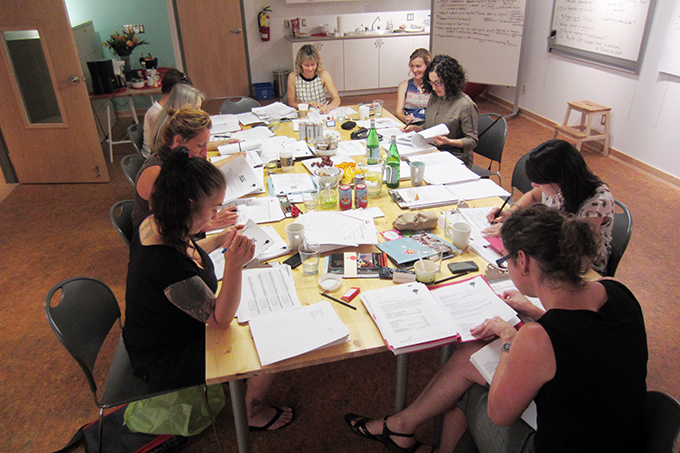April 28, 2016
Grant-Writing Advice From the Jury Box: Artists in the Classroom

Artists in the Classroom grants are adjudicated on a merit basis by a provincial jury made up of educators and professional artists from across BC. These jury members also have experience working on AIC-funded projects in their communities. Most of them reflect on what a valuable experience it is to see grant process from "behind the curtain". Reading so many applications gives them a new perspective when writing their next AIC grant application. So we decided to ask them to share some of these pearls of wisdom with those wanting to apply for an Artists in the Classroom grant.
"Above all, we are looking for sincere and honest proposals. All applications should clearly address the following: Make sure we can understand the process, timeline and desired outcome of the project; clearly outline the number of hours students will be working with the artist; demonstrate the collaboration process between the educator and artist."
There was very clear consensus from the jurors that they wanted to see clear and concise writing, collaboration between artists and educators, tailored engagement and learning outcomes, and detailed timelines and budgets. Each of these areas is described below with specific advice from the jury members.
The jury reads and discusses 100-150 applications in the review process. They are looking for clear and concise writing. Be explicit, not wordy. Remember that the jury doesn't necessarily know anything about your school, community, artist or project other than what you provide them. They do not have time to research or read between the lines. One juror suggested to "have someone read your application and summarize back to you what is written. Make sure your intentions and the breadth of the project are clear."
The grant guidelines (found here) provide a lot of valuable information about the granting process. It breaks down the four assessment criteria that the jury uses to evaluate your application. "The jurors will expect to find your clearly articulated short answers in the appropriate location on the application and will calculate the value of your responses accordingly."
The jury wants to see that your project is a collaboration between the artists and teachers, but also that each person understands their role. "The best proposals show careful thought and a great connection between the artist and the school." Get to know each other in advance; get comfortable with the classroom and the artistic medium. Develop a shared vision and shared language to make sur you're on the same page. "But please remember teachers often feel very harried and time-pressured—so be extremely respectful, punctual, flexible and understanding when asking for their time and attention."
Teachers are responsible for the pre- and post- activities around the project and for linking it to their pedagogical practice. The jury likes to see that the project will have a long-lasting impact and that the teachers are learning alongside their students. Artists are facilitating creativity and expression, but also acting as co-creator along with the teacher and students. They are not only present with their expertise but as living examples of a worthy and valued career choice.
The process should be designed so that students are at the centre and learning outcomes are tailored to the school and class. The jury is looking for student engagement in and ownership of the idea, the process and the outcome. "The students should always come first."
They want to see how subject areas are integrated into the project and affect learning outcomes that are specific to the school and/or class. Explain how the project meets the goals of the school. Take advantage of the new curriculum's focus on inquiry-based learning. "Each school is unique and the proposal should reflect the individuality of the school."
The jury is also looking for a detailed timeline and budget so that they can conceptualize the plan and have confidence that the collaborators will be able to execute it. "Take the time to walk through the proposed schedule and be thorough when discussing expectations of the artist and the classroom teacher." They want to see clearly how much time the artist is spending with the students. Double check your numbers and provide enough detail so that your budget makes sense to an outsider.
Some other pearls from the jurors:
- "Consider how will the project 'change the world' and make real world connections for students."
- "Be passionate about what you are trying to accomplish. Look at the 'why?'"
- "Take lots of photos if you can—maybe arrange for the kids and the educator to help. Everyone will be happy afterwards to see themselves in action!"
Thanks to these past jury members for their generosity in sharing their insights: Terry Taylor, Leslie Bolin, Karen DeCicco, Tina Farmilo, Theresa Browning, Laura McGregor, Paula Scott and Kevin Ault.
So much great advice! Better get cracking on your own Artists in the Classroom grant application. You can start by taking the AIC Eligibility Quiz to find out if you're a good candidate. Then read the full grant guidelines and familiarize yourself with the Application Form found here.
Questions? Contact Emily Beam, Grants Manager at [email protected] or 604-336-0626 ext 110.
Read other posts in this series:
Past Stories
Search by category
Accessibility | AIC Projects | Arts Integration in Action | ArtStarts Artists | ArtStarts Team | Community Events and Engagement | Exhibitions | Grants | Guest Blog | Infusion Pro-D | Knowledge Philanthropist | Meet a Community Art Star | Showcase | Supporters | The Next 20

